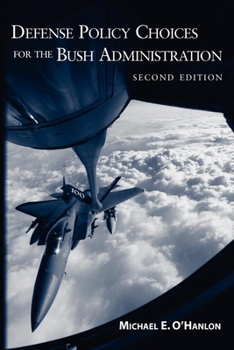Defense Policy Choices for the Bush Administration
" This updated edition incorporates lessons from the war in Afghanistan, other developemnts since September 11, and a critical assessment of the Bush administration's defense strategy and budget plan, both of which were formulated and publicly unveiled after the release of the book's first edition. ""O'Hanlon has insightfully separated what the nation needs to maintain an adequate defense from what the military and its suppliers want, crafting a...
Format:Paperback
Language:English
ISBN:0815764375
ISBN13:9780815764373
Release Date:June 2002
Publisher:Brookings Institution Press
Length:232 Pages
Weight:0.77 lbs.
Dimensions:0.6" x 5.9" x 9.2"
Customer Reviews
2 ratings
Solid "Dollars and Sense" discussion of defense spending
Published by Thriftbooks.com User , 22 years ago
....This book is solid shop talk for those interested in defense policy, broaching many issues while consistently focusing on ways to limit (but not necessarily reduce) defense spending. O'Hanlon argues that aggregate defense spending must increase modestly to preserve US interests at home and abroad, but that sensible cuts can be made elsewhere to offset the increase. Some expenditures should be considered essential, such as replacing aging equipment which was acquired during the Reagan administration. However, these costs can be tempered by limiting, though not eliminating, acquisitions of cutting edge technology while replenishing fleets with existing, effective, and less costly technology. O'Hanlon makes a compelling argument (financial and otherwise) in favor of moving away from a two-war defense framework to one which enables the US to simultaneously tackle three engagements of varying intensities, something on the level of Desert Storm plus Desert Shield plus Bosnia / IFOR. Many of O'Hanlon's arguments on homeland defense, while valid, have been discussed in more detail elsewhere (e.g. "America's Achille's Heel"). His arguments for a limited missile defense (focusing primarily on boost-phase missile intercepts and the need for additional research) are solidly stated, and probably more so in his book "Defending America". A very thorough discussion of the China-Taiwan issue is provided, exploring potential military threats from both sides in detail. O'Hanlon argues that China's current military threat to Taiwan is almost negligible and that only a Chinese blockade of the island would be likely to require outside military intervention. The military and tactical strengths and weaknesses of both countries are discussed in turn, while exploring the delicate line the US must walk between antagonism and pacification in the region.
Core Reading, Treats Traditional Defense in Isolation
Published by Thriftbooks.com User , 22 years ago
Every citizen needs to read and think about the future of national defense. This book is one of the core readings.Among the recommendations in this book that make it essential reading for anyone concerned with streamlining and revitalizing national security, I consider the following to be sensible: 1) cost savings should not be achieved through the wholesale abandonment of overseas commitments (13); 2) achieve additional cost savings as well as increased operational utility by sharply limiting spending on the most advanced weapons and mobility systems, applying the savings to maintaining readiness and buying larger numbers of "good enough" weaponry (83); 3) citing Stephen Rosen-he could also have cited Colin Gray-he urges a slowdown in the so-called Revolution in Military Affairs (RMA) while emphasizing that true RMA's are less about technology and more about the very best mix of people, time, and information to produce innovation (88); 4) in this vein, he noted the continued excessive focus on mobility platforms rather than C4I or joint service experimentation (90); 5) homeland defense needs several billion more dollars per year (129), a recapitalization of the U.S. Coast Guard by with at least a $750 million a year increase (135), and a sharply increased focus on setting C4I security standards for unclassified communications and computing networks across the nation, with roughly $100 million a year additional; 6) politely put, National Missile Defense is best conceptualized as theater missile defense (TMD, 143); and 7) Taiwan would be a nightmare for all sides.Among the assertions in this book that give me pause are 1) defense down-sizing in the past ten years has been successful, trimming a third of the budget and manpower while retaining quality and cohesion (p. 1); 2) that 3% of the Gross Domestic Product is adequate for defense spending and we do not need to go to the less-than-traditional 4% (3-4); 3) that the Marine Corps should be employed to relieve Army troops in the Balkans (57) or Korea (80); 4) that North Korean armored forces would have great difficulty breaking through Allied lines to Seoul (71); 5) that rogue nations like North Korea would attempt to provide their infantry with chemical protective gear when using chemical weapons (73); 6) that US airpower is both a rapid-response solution for distant threats as well as an overwhelming response for sustained threats (76, passim); 7) that arsenal ships are survivable in off-shore loiter mode (111); and 8) that an overseas deployment rate of 8% of the total force is too high (227).Having said that, and with all my reservations about a book, no matter how talented the author, that does not preface its discussion of force structure with a review of the recommended strategy, and a discussion of the recommended strategy with a review of the real-world right-now threat, I have to rate this book a solid four in terms of seriousness of purpose and utility of content. It would be twice as v





